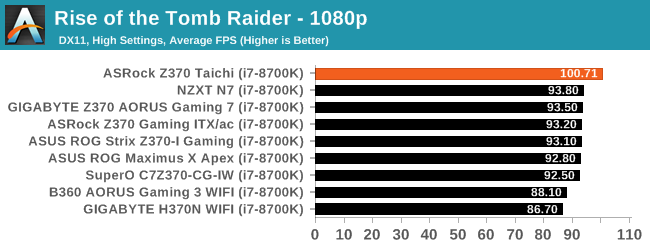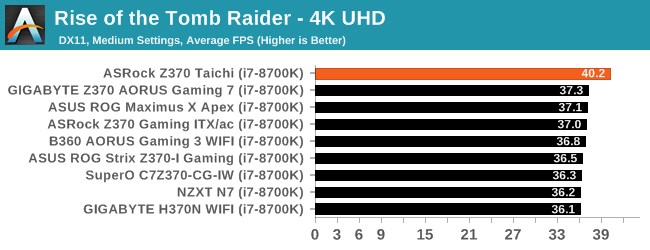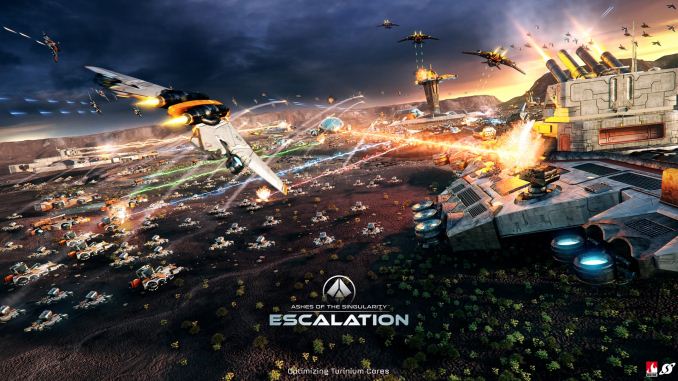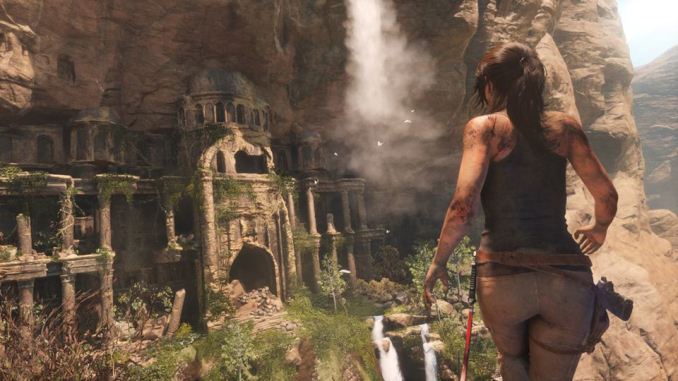The ASRock Z370 Taichi Motherboard Review: Competitive at $220, Aggressive at $190
by Joe Shields on July 20, 2018 1:15 PM ESTGaming Performance
AoTS Escalation
Ashes of the Singularity is a Real Time Strategy game developed by Oxide Games and Stardock Entertainment. The original AoTS was released back in March of 2016 while the standalone expansion pack, Escalation, was released in November of 2016 adding more structures, maps, and units. We use this specific benchmark as it relies on both a good GPU as well as on the CPU in order to get the most frames per second. This balance is able to better display any system differences in gaming as opposed to a more GPU heavy title where the CPU and system don't matter quite as much. We use the default "Crazy" in-game settings using the DX11 rendering path in both 1080p and 4K UHD resolutions. The benchmark is run four times and the results averaged then plugged into the graph.


Our AOTSe results here on the Z370 platform are just as close together as our results on the X299 platform. The results can tell us AOTSe can do all of its work with a 6c/12t processor without losing a step to the higher thread count CPUs. The Z370 Taichi managed 45.8 FPS in 1080p and 33.6 FPS in 4K. The results here are on the faster side of results but nothing out of the ordinary.
Rise of the Tomb Raider
Rise of the Tomb Raider is a third-person action-adventure game that features similar gameplay found in 2013's Tomb Raider. Players control Lara Croft through various environments, battling enemies, and completing puzzle platforming sections, while using improvised weapons and gadgets in order to progress through the story.
One of the unique aspects of this benchmark is that it’s actually the average of 3 sub-benchmarks that fly through different environments, which keeps the benchmark from being too weighted towards a GPU’s performance characteristics under any one scene.


Rise of the Tomb Raider results showed a marked improvement using the latest updated OS, microcode and ensuring the HPET timing is off. The Taichi ran at 100FPS in 1080p and 40.2 in 4K UHD. The 1080p result is over 7% faster than the next highest, while the 40.2 result is a bit less than 10% faster.












32 Comments
View All Comments
JoeyJoJo123 - Friday, July 20, 2018 - link
I see native PS/2 port as a plus. Don't use it? Don't buy it. There's plenty of boards out there that don't have it.I have (although I don't regularly use) an IBM Model M keyboard. PS/2 is the standard interface it uses. I'd much prefer to plug it into a native port rather than trying to use a USB adapter and having to deal with key rollover issues due to how usb polling works. The PS/2 bus is inherently interrupt based. As soon as a key is pressed, it's registered, so naturally it's NKRO.
My daily driver keyboard is just a Filco Majestouch 2, just because of the slimmer bezel and brown switches have a lower noise threshold. But I do enjoy plugging the Model M in from time to time, such as trying it out for rhythm games that use keyboard input, etc.
Myrandex - Friday, July 20, 2018 - link
Thank goodness, I still use my PS/2 port all the time, better implementations for sure than many USB variantsFlunk - Friday, July 20, 2018 - link
It costs a few cents to add, so I'd say it's better than not having anything there. 4 USB ports is enough for anything I'd want to do with this board. I'd rather not pay for the Wi-Fi, but apparently that's a thing people want built in to their desktop boards?Oxford Guy - Saturday, July 21, 2018 - link
It supports the x86 architecture, too!imaheadcase - Sunday, July 22, 2018 - link
You do know that many commercial hardware devices still use PS/2 ports for latency purposes? Lots of specialized hardware requires it.sonny73n - Sunday, July 22, 2018 - link
@inighthawkiYours is the dumbest comment of the day or maybe you’re just trolling.
My beloved mechanical keyboard has usb interface but I had it connected to the PS/2 port thru an adapter. Go figure!
empleat - Saturday, November 23, 2019 - link
Haha actually PS/2 is better than usb, it has lower input lag, because it doesn't have to go around some stations and send data as they are available and doesn't wait until polling occurs. Also usb generates a lot of dpc latency, if you don't have it in msi-x mode, tho newer mobos, should support it. Didn't look, what has lower dpc latency, if ps/2, or usb tbh, because i can't use ps/2 unfortunately, mouse and keyboard i use doesn't support. But ps/2 should have still lower input lag... You actually should prefer ps/2, even some knowledgeable poster recently from linustechtips told me so.PeachNCream - Friday, July 20, 2018 - link
I don't get how you go from naming a product Taichi which is basically hinting at martial arts style to a motherboard festooned with cogs and gears. The name is significantly detached from the visual appearance to the point where the two are in conflict with one another and it all boils down to muddled branding nonsense.Oxford Guy - Saturday, July 21, 2018 - link
The metaphors are broken anyway, since they're computer motherboards. It's like Intel putting a skull on an SSD. Absurdity.atragorn - Friday, July 20, 2018 - link
On your home page you have "Zen in midrange" on the photo don't you think that is misleading ?When you say Zen most people probably think you mean AMD's new CPU lineup.
At least I did at first.